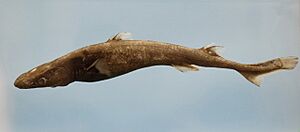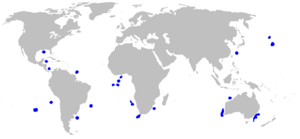Blurred lanternshark facts for kids
Quick facts for kids Blurred lanternshark |
|
|---|---|
 |
|
| Conservation status | |
| Scientific classification | |
| Genus: |
Etmopterus
|
| Species: |
bigelowi
|
 |
|
| Occurrences of the blurred lanternshark | |
The blurred lanternshark (Etmopterus bigelowi) is a type of dogfish shark. It belongs to the Etmopteridae family. This shark lives all over the world. You can find it deep in the ocean. It lives both near the bottom (benthic) and in open water (pelagic). It can be found from about 110 meters (360 ft) to over 1 kilometer (0.6 mi) deep.
This shark is part of a group with the smooth lanternshark. They both have special skin scales. These scales are flat-topped and arranged unevenly. This makes their skin look "smooth." Both sharks have thin bodies and long heads. They have two fins on their back with spines. They do not have an anal fin (a fin on their underside). They also have special parts called photophores that glow. The blurred lanternshark is bigger. It can grow to 67 cm (26 in) or more. This shark eats small squid, fish, and fish eggs. It gives birth to live young. Conservation groups say it is not in danger. This is because it lives in many places. Also, fishing does not seem to harm it much.
Contents
Meet the Blurred Lanternshark
What's in a Name?
Scientists Shigeru Shirai and Hiroyuki Tachikawa described the blurred lanternshark in 1993. They wrote about it in a science magazine called Copeia. They were studying a group of sharks. This group included the smooth lanternshark.
Shirai and Tachikawa found that the blurred lanternshark was a new species. They named it E. bigelowi. This name honors Henry B. Bigelow. He had studied this shark before. But he did not realize it was a different species.
How it's Different
The blurred lanternshark is special. It has unique skin scales. These scales are flat on top. They are also arranged in an uneven way. This makes the shark look "smooth." Sometimes, people call this shark the smooth lanternshark. Or they call it the blurred smooth lanternshark.
Where it Lives and What it Likes
Ocean Home
Blurred lanternsharks have been found all over the world. They live near continental shelves and slopes. They also live around underwater mountains called seamounts.
In the Atlantic Ocean, they are found from the Gulf of Mexico to Argentina. They also live off western and southern Africa. In the Indo-Pacific, they are seen near Okinawa and Australia. They are also found on seamounts in the central North Pacific. And they live off Peru.
Deep Water Life
This shark often lives in open water. It can be found from 110 to 700 meters (360 to 2,300 ft) deep. Near the ocean bottom, it lives from 163 meters (535 ft) to over 1 kilometer (0.6 mi) deep. Like many other lantern sharks, adult sharks live deeper than younger sharks.
What Does it Look Like?
Size and Shape
The blurred lanternshark can grow to at least 67 cm (26 in) long. It has a thin body and a large head. Its tail is short. The front of its head (snout) is shaped like a wedge. It is a bit flat and pointy.
Eyes and Mouth
Its nostrils are big. They have small skin flaps in front. The eyes are oval shaped. They have a deep notch in front. The mouth has long grooves at the corners. These grooves reach halfway to the first of its five gill slits.
The shark has many rows of teeth. In its upper jaw, it has 19 to 24 rows. Each tooth has a narrow point. It also has 2 to 4 pairs of smaller points. Older male sharks have more points on their teeth. In the lower jaw, it has 25 to 39 rows of teeth. Each tooth is sharp like a knife. The teeth fit together to form a single cutting edge. As males and females get older, their lower teeth become more upright.
Fins and Skin
The first fin on its back (dorsal fin) is closer to its side fins (pectoral fins). It has a straight spine in front. The second dorsal fin is taller than the first. It has a longer, curved spine. The pectoral fins are rounded. The fins on its belly (pelvic fins) are medium-sized and angular. There is no fin underneath its body (anal fin). Its tail is narrow. The tail fin has a well-developed lower part. The upper part is wide with a notch near the tip.
The shark's skin scales are small and blocky. They are packed together unevenly. Each scale has a flat top. The shark is brown or gray on top. It has a light spot on its head. Its underside is black. This black color extends in faint marks over its head, under its side fins, over its belly fins, and under its tail.
Glowing Parts
Like other lanternsharks, the blurred lanternshark has special glowing parts. These are called photophores. They are not in clear bands.
The blurred lanternshark looks very much like the smooth lanternshark. But the blurred lanternshark is larger. You can tell them apart by counting the turns inside their gut. The blurred lanternshark has 16 to 19 turns. The smooth lanternshark has 10 to 13 turns.
What it Eats and How it Reproduces
Shark Diet
The blurred lanternshark eats different things. Its diet includes squid. It also eats smaller dogfish sharks. It likes lanternfishes and fish eggs too.
How it Has Babies
This shark reproduces in a special way. It is called ovoviviparous. This means the eggs hatch inside the mother's body. The baby sharks grow inside using a yolk sac. They are born live. When they are born, they are about 16 cm (6.3 in) long.
Male sharks become ready to have babies when they are about 31 to 39 cm (12 to 15 in) long. Female sharks are ready when they are about 38 to 47 cm (15 to 19 in) long.
Interactions with Humans
Blurred lanternsharks are harmless to people. They are not important for commercial fishing. But sometimes, they get caught by accident. This happens in deepwater fishing nets. Then they are usually thrown back into the ocean.
The International Union for Conservation of Nature (IUCN) has looked at this species. They say it is of Least Concern. This means it is not in danger. This is because it lives in many places. Also, there is no sign that a lot of them are being caught by fishing.


